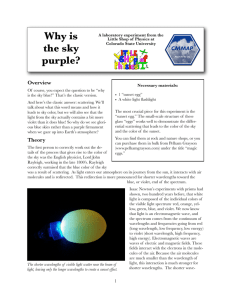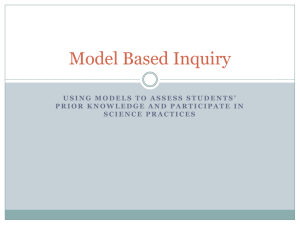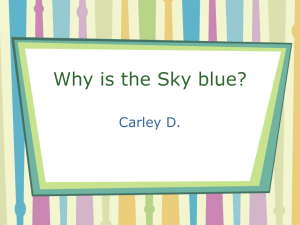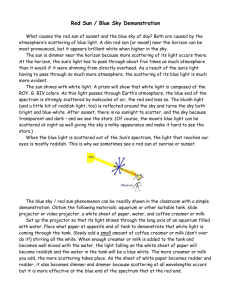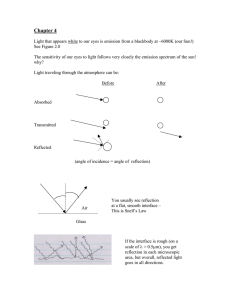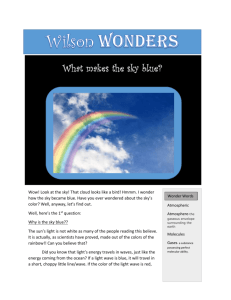Why is the sky purple? CMMAP
advertisement
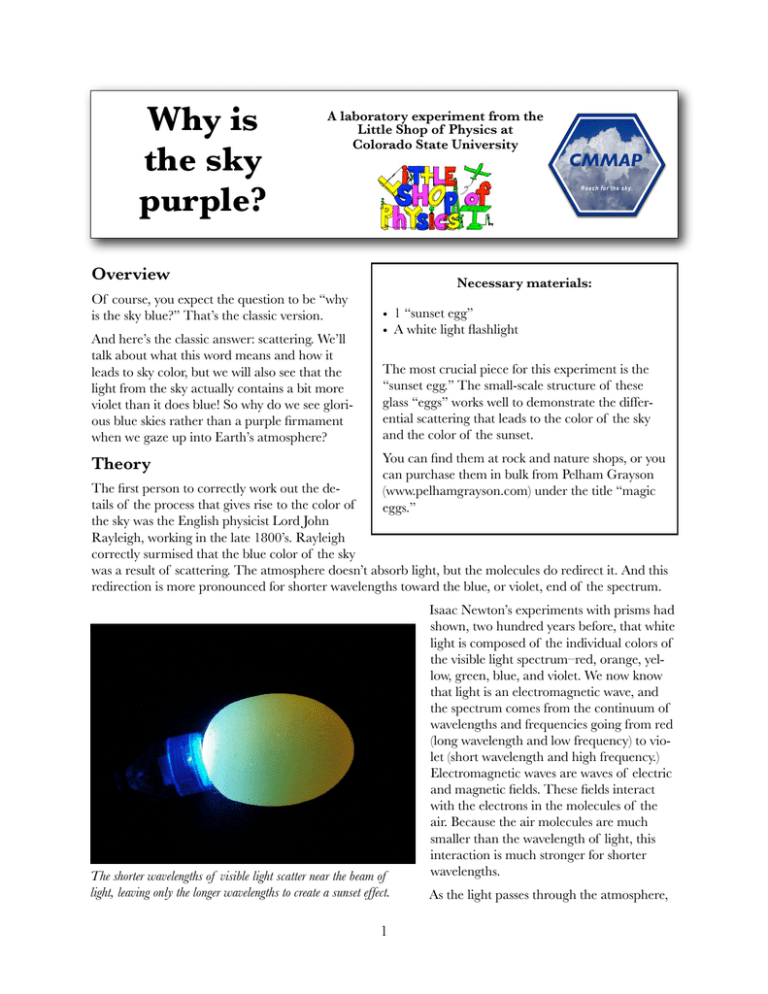
Why is the sky purple? A laboratory experiment from the Little Shop of Physics at Colorado State University Reach for the sky. Overview Of course, you expect the question to be “why is the sky blue?” That’s the classic version. And here’s the classic answer: scattering. We’ll talk about what this word means and how it leads to sky color, but we will also see that the light from the sky actually contains a bit more violet than it does blue! So why do we see glorious blue skies rather than a purple firmament when we gaze up into Earth’s atmosphere? Theory CMMAP Necessary materials: • 1 “sunset egg” • A white light flashlight The most crucial piece for this experiment is the “sunset egg.” The small-scale structure of these glass “eggs” works well to demonstrate the differential scattering that leads to the color of the sky and the color of the sunset. You can find them at rock and nature shops, or you can purchase them in bulk from Pelham Grayson (www.pelhamgrayson.com) under the title “magic eggs.” The first person to correctly work out the details of the process that gives rise to the color of the sky was the English physicist Lord John Rayleigh, working in the late 1800’s. Rayleigh correctly surmised that the blue color of the sky was a result of scattering. The atmosphere doesn’t absorb light, but the molecules do redirect it. And this redirection is more pronounced for shorter wavelengths toward the blue, or violet, end of the spectrum. The shorter wavelengths of visible light scatter near the beam of light, leaving only the longer wavelengths to create a sunset effect. 1 Isaac Newton’s experiments with prisms had shown, two hundred years before, that white light is composed of the individual colors of the visible light spectrum–red, orange, yellow, green, blue, and violet. We now know that light is an electromagnetic wave, and the spectrum comes from the continuum of wavelengths and frequencies going from red (long wavelength and low frequency) to violet (short wavelength and high frequency.) Electromagnetic waves are waves of electric and magnetic fields. These fields interact with the electrons in the molecules of the air. Because the air molecules are much smaller than the wavelength of light, this interaction is much stronger for shorter wavelengths. As the light passes through the atmosphere, the atoms actually absorb and reemit the light. This doesn’t change the intensity of the light, but it does change the direction. And this change in direction—which we call scattering— is ten times more pronounced for violet light than for red. This particular type of scattering is called selective scattering or Rayleigh scattering. Blue light has a short wavelength and a high frequency, so it is strongly scattered. When you look up at the sky, any light that you see has been redirected toward your eyes—it has been scattered. Because you are seeing only scattered light, the sky appears blue. But violet light has an even shorter wavelength and a higher frequency than blue light, so by all accounts the sky light should be violet! It appears there is more to the story! If we judge by the most prominent color, the sky is violet. But the sky appears blue due to the limitations of our eyes. Our sensitivity to light decreases as we reach the shortest wavelengths of the visible spectrum. The violet is there, but our eyes detect it only weakly. What we see is blue—present in large quantities and easily detected by our eyes. Doing the Experiment This straightforward experiment shows the blue color resulting from scattering, and also explains the red color of sunrises and sunsets. At sunrise or sunset, sunlight passes through a thickness of atmosphere 12 times that at midday, so light passes through 12 times more atmosphere at sunrise and sunset. When we greet the day or say goodnight, we see beautiful sights in the yellow, orange, and red part of the spectrum, for the shorter wavelengths have been scattered away. The experiment goes like this: • Place a white light at one end of the sunset egg. Look at the light that comes out the side of the egg. This is the scattered light; notice its color. This blue is the blue of the sky. • Next, look at the light that goes through the egg. This is the transmitted light—all of the light that isn’t scattered. What’s left when you remove the short wavelengths? Reddish light! • Try the light on the other end of the egg, or on the egg’s side. What do you notice now? • Ask your students how they would use this experiment to explain blue skies and red sunsets. • Try different white light sources. Depending on the tint and the intensity of the light, you’ll get some interesting variations. Summing Up The scattering from the crystals in the egg is selective scattering, just like that in the atmosphere, so you can use it to demonstrate the color of the sky and the color of the sunset. You can get similar selective scattering from other things; unflavored gelatin works well, as does a weak solution of milk in water. But these eggs don’t spill and don’t spoil! For More Information CMMAP, the Center for Multi-Scale Modeling of Atmospheric Processes: http://cmmap.colostate.edu Little Shop of Physics: http://littleshop.physics.colostate.edu 2
